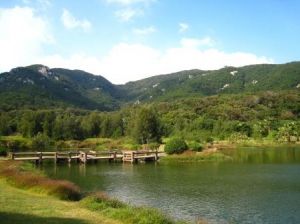Difference between revisions of "Mount Putuo"
imported>Ciic m (Created page with ''''Mount Putuo''' (http://english.cri.cn/725/2006/04/26/202@81783.htm) is one of the Zhoushan Islands in the East China Sea, and one of the Four Sacred Buddhist Mountains...') |
imported>Ciic |
||
| (One intermediate revision by the same user not shown) | |||
| Line 1: | Line 1: | ||
| − | |||
[[File:Mount Putuo.jpg|thumb|Mount Putuo]] | [[File:Mount Putuo.jpg|thumb|Mount Putuo]] | ||
| − | [[category: | + | '''Mount Putuo''' ('''普陀山''') is one of the [[Zhoushan Islands]] in the [[East China Sea]], and one of the Four Sacred Buddhist Mountains in [[China]]. |
| + | |||
| + | As the place where worshipping rites for Guanyin, the Goddess of Mercy, are held, Mount Putuo was dubbed “Buddha Land in the Vast Sea” in the [[Song Dynasty]] (960-1279). | ||
| + | |||
| + | There are three famous monasteries at Mount Putuo: Puji (Universal Relief) Temple, Huiji (Wisdom and Blessing) Temple, and Fayu (Dharma Rain) temple. It has also the Duobao Pagoda dating to the [[Yuan Dynasty]] (1279-1368); a stone tablet with a carved image of Guan Yin, the Goddess of Mercy, dating to the Ming Dynasty (1368-1644); and the “Nine-Dragon Hall” of the Ming Dynasty palace, which originally stood in [[Nanjing]] and was dismantled and reassembled on Mt. Putuo in early Qing Dynasty. | ||
| + | |||
| + | New additions to this Buddhist mountain in recent years include a stone pagoda with 500 arhats in bas-relief, a 33-m-tall bronze statue of the Goddess of Mercy in open air, and the red copper hall of the Zhengfajiang Temple that commands the highest point of Mt. Putuo. | ||
| + | |||
| + | [[category:mountains]][[category:attractions]] | ||
Latest revision as of 06:21, 24 June 2015
Mount Putuo (普陀山) is one of the Zhoushan Islands in the East China Sea, and one of the Four Sacred Buddhist Mountains in China.
As the place where worshipping rites for Guanyin, the Goddess of Mercy, are held, Mount Putuo was dubbed “Buddha Land in the Vast Sea” in the Song Dynasty (960-1279).
There are three famous monasteries at Mount Putuo: Puji (Universal Relief) Temple, Huiji (Wisdom and Blessing) Temple, and Fayu (Dharma Rain) temple. It has also the Duobao Pagoda dating to the Yuan Dynasty (1279-1368); a stone tablet with a carved image of Guan Yin, the Goddess of Mercy, dating to the Ming Dynasty (1368-1644); and the “Nine-Dragon Hall” of the Ming Dynasty palace, which originally stood in Nanjing and was dismantled and reassembled on Mt. Putuo in early Qing Dynasty.
New additions to this Buddhist mountain in recent years include a stone pagoda with 500 arhats in bas-relief, a 33-m-tall bronze statue of the Goddess of Mercy in open air, and the red copper hall of the Zhengfajiang Temple that commands the highest point of Mt. Putuo.
